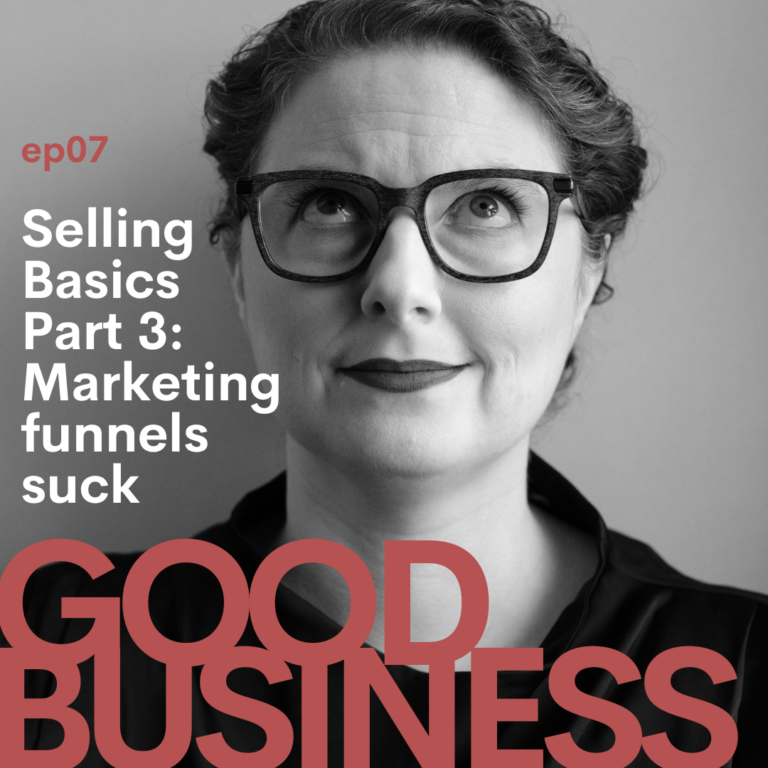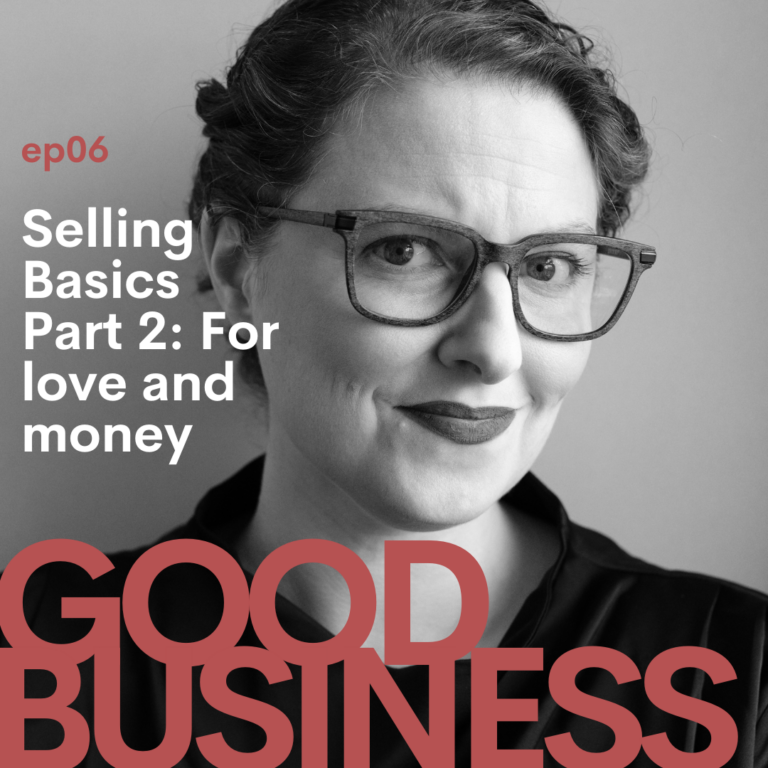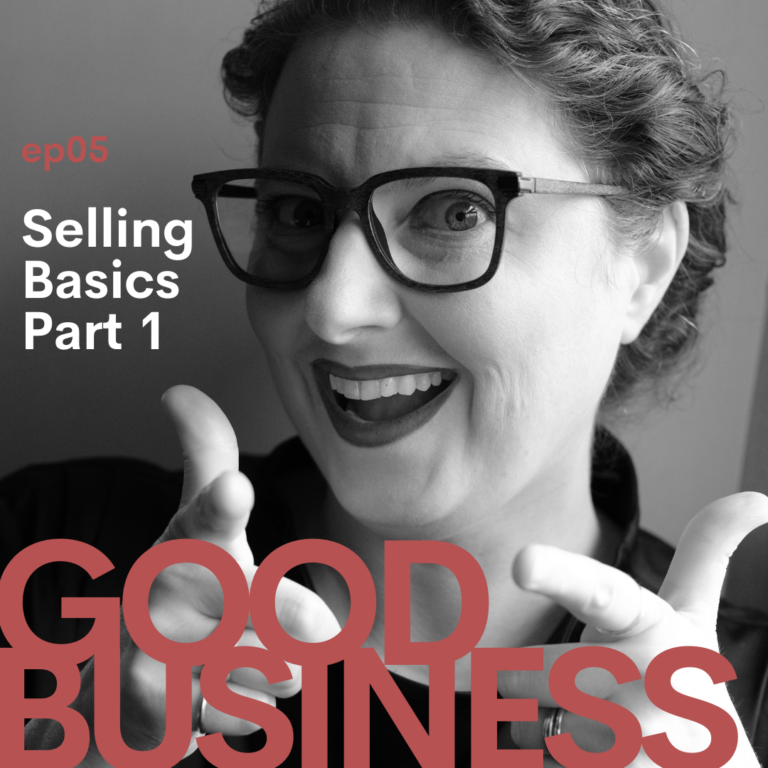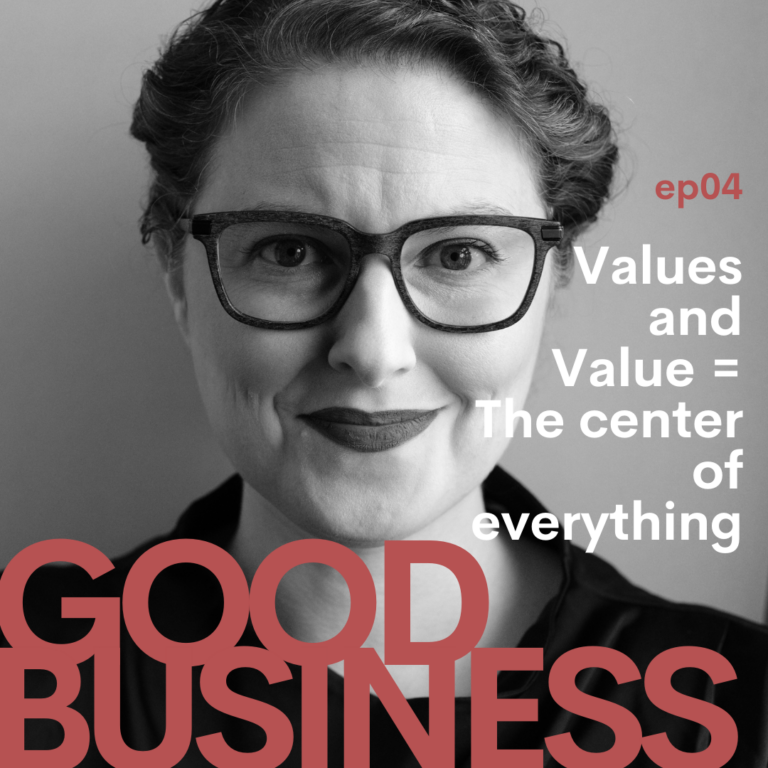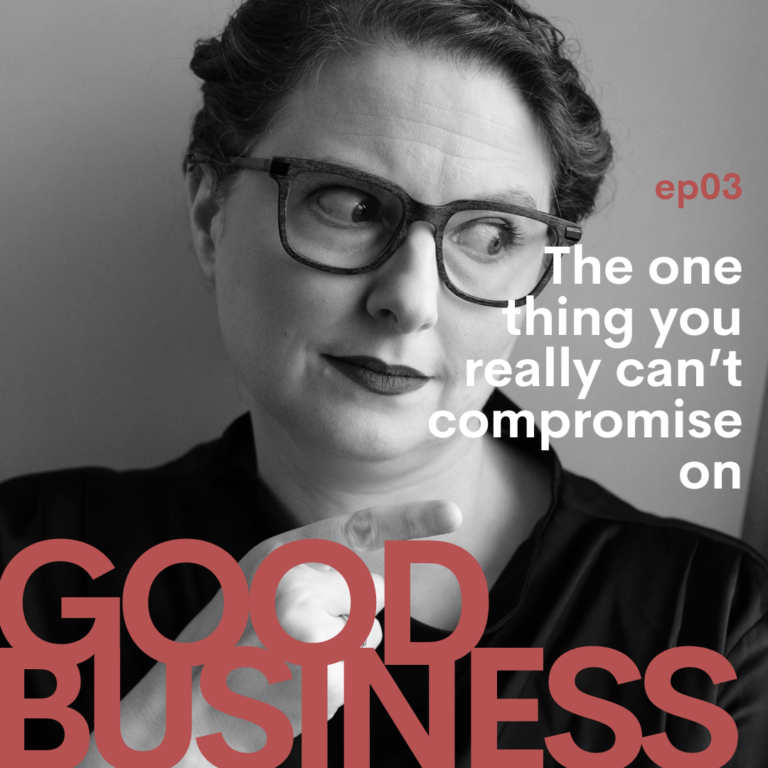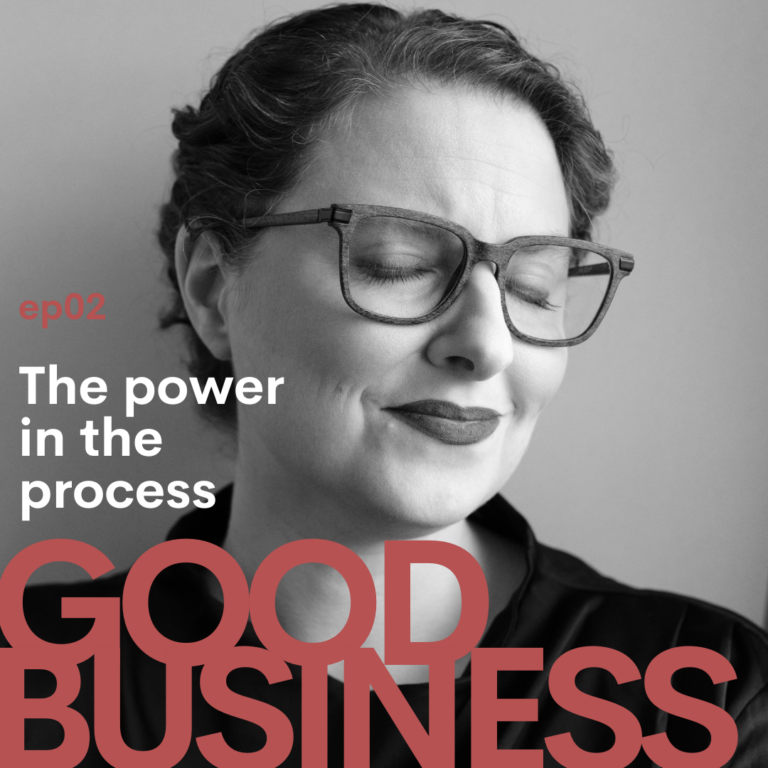Today’s episode is part four in our series on offer design. In this episode we talk about: What does done look like? In other words, what does the end of a client relationship look and feel like? And how do you know when you are done?
And are you even designing one with an ending?
Episode Transcript:
Welcome back to The Good Business Podcast. I’m your host Illana Burk and today we are delving into our offer design series. We’re now into part four. And today’s topic is what does done look like? This is, what does the end of a client relationship look and feel like? And how do you know when you get there?
And are you even designing one with an ending?
So first we’re going to look at how you think about this right from the jump? How do you think about finishing when you haven’t even started? And is that going to be different for every client? Or do you want an open-ended loop? Are you more interested in having an open-ended client relationship?
So we’re going to kind of look at two different things. The first is what is your offer look like and what suits you and your work best. An open-ended or close ended client relationship. And then second, assuming you’re looking at a close ended one, how do you know when you’re there? How do you know what finished looks like and how do you know when to walk away in service of both you and your client?
First things first. Do you want a closed loop or an open loop? Now the difference is relatively simple. Are you creating a business or an offer – specifically think about offers right now – are you creating an offer that has a chance for an ongoing relationship? Are you creating an offer that you get in you get out, there’s a beginning, a middle and an end, and then they go about their merry way? . There’s this is going to get a little mushy, because we’re going to cross over into talking about two different things here, Because from a business standpoint, you can create a business that has open-ended transactional loops where let’s say, back to our jewelry designer…
When a jewelry designer sells a pair of earrings, that’s a closed loop on the one transaction. But with the hopes of an open loop from a relationship standpoint. You want them to come back and buy more. You want to have a long and ongoing relationship with that client. Albeit unpredictable.
There’s no way to create regularity in a standard transactional, money for goods experience. Unless of course you create a subscription model of some kind, which is the ultimate open loop in product based selling. And this is something that is certainly having a moment in consumerism right now.
It’s good for the business. It’s often good for the consumer because they don’t have to think about reordering things that they use all the time. There are ways in which to do that. So don’t discount the ability to have an open loop if that’s truly what you desire and the model you want to create.
So let’s talk about the advantages and disadvantages of open and closed loops. We covered that a little bit for a product company, right? Let’s talk about it from a service-based perspective.
The difference would be a coaching package versus a retainer package. So a coaching package would look like six months, maybe an intensive upfront, and a certain number of calls every month, with a prescribed outcome. So you start here, I’m going to take you here. And when you’re done, you’re going to be here. There may be an option to re-up, but things are sold in very packagized concepts. A lot of times it’s paid for up front as if it’s a product. Maybe there’s a two pay option, but it’s rarely something that’s invoiced monthly. Versus an open loop, which looks more like a retainer. You pay me $2,000 a month and I offer you a certain level of service. Sometimes it’s a prescribed number of hours. Sometimes it’s a prescribed number of projects. Sometimes it’s simply open-ended: I’m available to you, if you need me.
But those hours are usually use it or lose it on an open end. Another version of an open-ended coaching relationship would be like how I did partnership coaching for a very long time. I would start with the request of a committed number of months. It’s been three. It’s been six. It’s currently at nine.
But it’s with the intention that they will very likely continue. That’s always been the way in which I’ve worked. Now that may be changing in the future, but currently that’s how I’ve always worked. That the idea is, I want to be sort of a temporary part-time business partner with you. I’m there when you need me, but we have an open-ended relationship. There’s no finality to it.
And for me, the way in which I know that I’m done is when someone stops needing me. When they stop calling me to help them through every problem. When they’ve gotten to a place where I’ve coached them enough, they’ve learned enough, they flex their skills enough that they can make really clear headed decisions on their own about their business and feel really confident in it without needing to talk to me. That’s what done looks like for me.
So we’ll get to that in a minute, but, in your deciding whether you want an open loop or closed loop, one of the most fundamental things is a simple question to ask yourself of. Do I like long-term relationships or short-term ones? Some people love getting in and getting out. They love the super fast, effective churn. They like the mix of new people and new ideas. And interesting stories. Whatever your business is. They like to get in and get out relationship. They don’t want to get deep into the longterm. Other people cherish the longterm. They want to go deep and they want to stay there. Whatever that means for your business. Of course, it’s variable, right? But if you want to have clients that you know, that you watch their kids grow up, that you love that deepening relationship, then you can definitely pursue that as a business pattern.
Now if you’re a product based business, that’s going to be more challenging. If you’re a service-based business, not so much. If you find yourself rejecting creating packages for your coaching or your design projects, then consider a retainer. That might feel more natural to you.
On the other hand, the other piece to consider as marketing. If you’re someone who’s pursuing longterm relationships with clients it means your capacity for new clients will always be low. And you need to be cultivating a referral pipeline that can support you long-term. Because it’s very likely that you won’t do a lot of marketing. Because if you don’t have a lot of openings very often, you’re not going to do a lot of marketing. If you’re somebody who’s kind of lazy about social media and not that interested in marketing, this is a pretty solid way to go. Because you don’t have to do as much of it because your people stay longer. So your new space stays lower. So over time, you don’t have to do as much outside of the work that you do with clients.
There is a danger to this though, because it can be, it can breed complacency over time. When you don’t market then when people leave, your pipeline dries up rather quickly. So it can maybe pretty vulnerable to downturns, if you have a few people that leave all at once.
Or if the economy tanks and people stopped buying whatever you’re selling -or whatever, external reason that you’re not really in control of- if you’re not marketing, you’re putting yourself in a relatively vulnerable position. That’s a liability to consider with long-term relationships. With short term relationships, you have the inverse problem. You have to hustle and sell all the time.
The shorter the engagement, the more you have to sell it. The bigger your list needs to be, the bigger your social reach needs to be. The more hustle you have to do, the more content creation, et cetera. Right? So if you have short-term engagements with people or you’re the kind of service where they only need you when they need you, then you’re going to need to understand that a much higher portion of your investment of both time and money will need to go towards marketing and bringing in new leads on an ongoing and continuous basis. Or you will end up dead in the water.
So long-term /short-term relationships. That’s what that looks like. So that’s how you know, that’s talking about like the shape of that loop.
How do you know when you’re finished? How do you know when the relationship has ended? Like I said, for me, it’s when they stop asking me about all kinds of small things. They stopped saying things like “I heard your voice in my head and I just wanted to run this by you.” I stopped hearing that.
That’s how I know what done looks like. And I listen for it. Sometimes it takes months. Sometimes it takes years. I’ve had clients that have been with me for six and seven years and we just sort of mutually realized we hit a point where they don’t really feel the need to get on a call. It might look like, calls get a little shorter. They come with fewer things to talk about. They don’t have the mile long list of all the things they want to talk through with me. And it becomes really apparent that we’re meeting out of habit and not out of need.
If you’re more transactional, then the ending of a relationship can be very clear. It might be when the transaction ends. But that doesn’t necessarily need to be the ending. Because you have to decide what your goals are going in. Again, what was the promise that you’re making? If you’re selling jewelry, and the promise that you’re making is that somebody is going to feel better about themselves because they bought your jewelry, then the end of that transaction might not necessarily be when they purchase and get their receipt. It might be when you send a personal note, a couple of weeks later telling them that you are deeply grateful for their purchase, because that will have the effect on them. They will feel better about themselves because they did something good. For you.
So consider what the ending of a relationship might look like. It may have different permutations. It might be more or less than you’re already doing. But don’t take for granted that what you’re doing is the right thing. Look closer. What’s the very best way you can end a relationship? And how do you know when you’re there?
All right, everybody. On our next episode, we are going to be talking about creating offers that allow you to do more or less of the impact that you want to have and how to consider impact as part of your offer design. I hope you’ll all join us. And have a great day.
More Episodes
The Ethical Selling Part 3: Marketing Funnels Suck | GB07
Marketing Funnels. What they are (and aren’t). Why I think they’re a terrible way to structure a client relationship. And what to do instead. The idea today is to show you why and how to look deeper at the prevalent logic that you HAVE to do this to be successful. You don’t.
Selling Basics Part 2: For love and money | GB06
Today’s focus is on how to love selling by loving your clients (or potential clients) first. Loving the people you’re selling to is a HUGE part of making selling into something you adore. It’s not just an esoteric concept. It’s...
Selling the right way: Part 1 | GB05
Selling is a conversation. A communication. It’s how you show yourself to your community. The confusion happens when we see people we like, look up to, and respect using sales tactics that belie their stated mission.
Values and Value: The Center of EVERYTHING | GB04
Your values affect your your deepest work, how you make decisions, how you operate externally from yourself. It’s how you move through the world. Your value is how other’s experience it. Today’s episode is a deep-dive primer on why understanding both is critical.
The one thing to never compromise on | GB03
Business is FULL of opportunities for compromise. Options. Bad advice. The kind that tells you it’s OK to sacrifice your values. And as business owners, we are often asked to bend, shift, stretch. Change what we KNOW to be true to fit “The Rules”. Today we explore the one thing to NEVER do this on.
The Power in The Process | GB02
Process goes WAY beyond systems setup. Today, we talk about how identifying the ways in which your process is slowing your growth can be one of the most valuable exercises you can do to thrive and grow.

